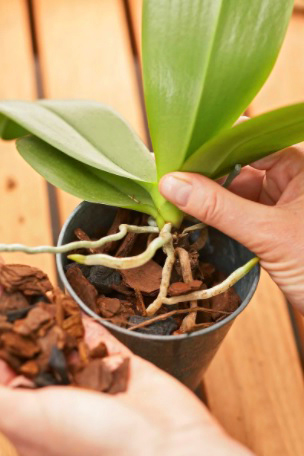
ORCHID CARE AND TIPS

Q: How often should I water my orchid?
The general rule of thumb for orchids grown in the home is to water every 5 to 12 days, depending on the type of orchid, the temperature the plant is grown in, and the time of year. During the warm summer months when days are long, more frequent watering is required than in the cooler, shorter days of winter.
Varieties to keep evenly moist (not soggy or wet) at all times: Paphiopedilum, Miltonia, Cymbidium, Odontoglossum
Varieties to keep evenly moist during active growth, allowed to dry out between waterings when not: Cattleya, Onicidium, Brassia, Dendrobium.
Varieties to keep nearly dry between waterings: Phalaenopsis, Vanda & Ascocenda.
Q: How often should I be fertilizing my orchids?
A: Be sure to use an orchid food that is formulated for orchids and follow the instructions on the label. In general, most orchid fertilizers recommend usage once a month. Less frequent fertilizing may stunt growth and inhibit flowering; more frequent fertilizing may burn the roots and leaves and inhibit flowering.
Q: What do I do when my phalaenopsis stops blooming?
A: If your plant has healthy, with thick, green leaves that have not become wrinkled or drooping, cut the old flower stem up high, just above a node and just below the lowest bloom. The plant will frequently send out a new flowering branch at that location. If your plant has thin, wilted leaves, or if the plant is small, with only 3-to-4-inch-long leaves, it is best to cut the flower stem all the way down, so that the plant does not weaken itself by blooming again right away. Carefully water and fertilize your plant to build it back into shape for future flowering on a brand-new stem. This can take up to a year or more, as Phalaenopsis, like most orchids, is a relatively slow-growing plant.
Q: I am growing my phalaenopsis orchid in the house but they never bloom. What can I do?
A: The most common reason for any orchid not to bloom is insufficient light. Move your phalaenopsis plants to a window where they will receive strong, but indirect light (near a south-facing window is ideal). You might also try lighting your plants with a fluorescent light fixture placed about 1-2 feet above the foliage. Give up to 12 hours of supplemental light per day. Phalaenopsis will also develop flower spikes in response to a cool period of about four weeks with night temperatures of 55F. After the cool treatment, raise the night temperature back to the normal 60-65F minimum. See if these changes to your growing conditions help to stimulate your plants to bloom.
Q: How do I know if my orchid is getting the proper amount of light?
A: One good indicator is leaf color. Generally speaking, the leaves should be bright green rather than dark green. Dark green indicates too little light while reddish green indicated too much light. Those orchids requiring higher light intensities, such as cattleyas, dendrobiums and oncidiums, should be placed in a south or west facing window, but be sure to protect the leaves from the hot mid-day sun with sheer curtains or move the plants back from the window on hot summer days. Miltonias, phalaenopsis and paphiopedilums prefer lower light intensities and should be located further away from the window or placed in a window facing east or north.
Q: The orchid in my window suddenly developed black blotches on the leaves. Is it sick
A: It sounds like your plant has a bad case of sunburn! Longer, brighter days can increase the light intensity in your window so that the leaves get too hot and burn. You need to move your plant back from the window or put up sheer curtains to help protect it from direct sunlight. As the light intensity decreases in the fall, move your plant closer to the window again. Frequently check their leaves and watch for any fading of their green color, especially on those parts of the leaf closest to the window. This is an early indication that they are being exposed to too much sun.
Q: How do I know if I need to re-pot?
A: A newly potted phalaenopsis should be able to remain in its growth media two years before repotting. When there are many, long roots over the edge of the pot, this plant has most likely been growing for several years since its last repotting. If your plant is not currently in bloom, you should repot now. Be sure to remove all dead roots that are usually dark-colored, soft and mushy. Sometimes they may be dry, with a fiber running through the middle of the root. Center the plant with all of its roots down in the pot and add moistened bark until the level of the bark is just below the bottom of the lower set of leaves. Wait a week before resuming your normal watering and fertilizing routine.
Q: My phalaenopsis has been in flower for quite a while and now it seems to be forming what looks like a new plant on the flower stem! Will it grow if I pot it and what type of soil is best?
A: Congratulations! With proper care you will have a new plant, identical in every way to your original phalaenopsis. Wait until the new plant has developed a strong little root system of its own, with two or three roots at least one to two inches long. Then, carefully cut the plantlet, called a keiki, from the flower stem and put it in a very small pot of seedling bark for its first potting. After a year or two, move up to medium-sized bark in a four to five inch pot. Alternatively, you can pot the keiki in special orchid sphagnum moss. Be sure to go light with the fertilizer for the first few months. Once the plant has established itself, as evidenced by increased leaf growth, start with full-strength fertilizing.
Q: What are the most common orchid pests?
A: There are several insect pests that are common: Aphids (small sucking insects) and thrips (small chewing insects) attack tender new growth, flowers and buds. Scale insects form a brown or black crust on leaves and stems. Mealybugs also attack the leaves and stems forming a white cottony mass. Consult a local garden center for products to control these pests.
rline;”>Late Winter – Early Spring You will want to cut back each of the old flowering stems to 4 to 6 inches in height. Do this in March or April. This will promote new growth. Late Spring – Summer Repot into a pot 2-3” larger than the original. Be sure the soil is moistened and place in a sunny window. When all danger of frost has passed and night temperature is above 60°F the plant can be placed outdoors. Place the poinsettia in a shady location for two to three weeks to allow it to become acclimated to the new environment. Then sink the pot in a sunny protected outdoor flowerbed. Turn the poinsettia pot regularly to prevent rooting through the bottom hole. It is suggested that a quarter turn each week will prevent this and will also help to keep the plant growth even all around the pot. If the pot is not turned, one side may get more sun than the other. Light shade during the afternoon is okay. Keep the plant growing actively all summer by regular watering and feeding every two weeks with a complete water soluble fertilizer (20-20-20). If you prefer a short plant with many flowers, pinch out the growing shoots to encourage branching. Pinching should produce more flowers and a nice bushy plant. This should be done at 3 to 4 week intervals, according to the speed of growth. Pinch out the top 1/4-inch by hand. Two or three large fully expanded leaves should be left below the pinch; this serves as a guide for knowing when the shoots are ready for pinching. Continue this practice until mid- August, when the plant should have a satisfactory shape and number of shoots. Keep the plant growing actively all summer by regular watering and feeding every two weeks with a complete soluble fertilizer (20-20-20). Fall Before night temperatures fall below 55-60°F at night, bring the poinsettia indoors to a sunny location. Check for pests and diseases and place poinsettia in a south window. Reduce the amount of fertilizer when the plant is brought indoors. The lower light intensity will reduce it’s need for food. Flowering is “photo periodically” induced in the poinsettia. This means that flowers begin to form when the days are a certain length, or, more accurately, when the nights are long enough. The poinsettia is a short-day or long-night plant. Without long nights, this plant will continue to produce leaves and will grow but will never flower. You must make certain it receives no light from any source. Very short periods of lighting at night may be enough to prevent or interfere with flowering. Even light from a streetlight can stop flowering. If the plant is to be grown in a room that is lighted nightly, cover it completely at dusk (5 p.m.) every day with a heavy paper bag, a piece of opaque black cloth, other light-tight cover or place in a dark closet. Flower initiation begins in late September and early October. Dark periods longer than 12 hours are necessary for flower set. Flowers mature in from 60 to 85 days depending on varieties, temperature and light intensity. Because flower initiation depends upon the length of the dark period, your poinsettia must be kept completely dark from5 p.m.to8 a.m.The time to give this treatment is from the end of September until the bracts show good color. Once you can see the flowers developing in the growing plants, i. e., when the floral bracts start to show definite color, it is not as important to continue giving the dark period, though it is advisable to continue until the bracts are almost fully expanded. Temperatures should be no less than 55°F at night, but not more than 70°F. During the day give the poinsettia as much sunlight as possible. High night temperatures, coupled with low-light intensity, low nutrition, dry soil or improper photoperiod may delay maturity.

